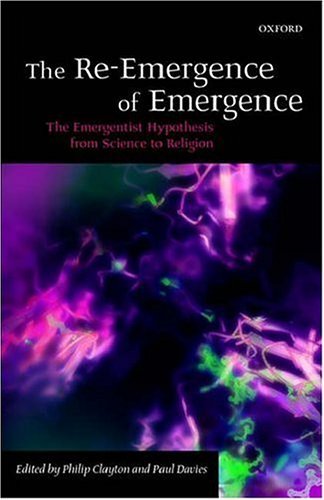© Copyright
JASSS


The Re-Emergence of Emergence: the Emergentist Hypothesis from Science to Religion
Clayton, Philip and Davies, Paul (eds.)
Oxford University Press: Oxford, 2006
ISBN 0199287147 (pb)
Order this book
Reviewed by
Johannes Lenhard
Department of Philosophy, Bielefeld University, Germany
 This book encompasses perspectives from various disciplines related to the concept of emergence. The subtitle "The Emergentist Hypothesis from Science to Religion" appropriately expresses the scope of the book and at the same time promises something more, that is to subsume different approaches under the heading of emergence. Furthermore, the title re-enforces this message by suggesting a coherent historical development, i.e. that recent dynamics are to be understood as re-emergence, a renewed and repeated emergence of emergence.
This book encompasses perspectives from various disciplines related to the concept of emergence. The subtitle "The Emergentist Hypothesis from Science to Religion" appropriately expresses the scope of the book and at the same time promises something more, that is to subsume different approaches under the heading of emergence. Furthermore, the title re-enforces this message by suggesting a coherent historical development, i.e. that recent dynamics are to be understood as re-emergence, a renewed and repeated emergence of emergence.
My review contains a twofold message: On the one hand, the book offers a number of valuable contributions and hence the book's subtitle is well addressed. On the other hand, the book pays little attention to the mentioned broader and highly intriguing claims. Readers like me are eager to learn about the more systematic and comprehensive questions that are suggested by the title, e.g. why does a re-emergence take place? What are the driving forces? Does recent science call for emergence? If so, why? These kinds of questions remain largely unaddressed.
The description of what is meant by "re-emergence" remains a bit vague. It is undecided between two options. Is the old discussion about emergence thought to be one century old? The introduction sketches groundbreaking contributions to emergentism during the 1920s and suggests that the re-emergence would start with the rise of complexity theory and related issues in the 1960s. The general credo is that there are "at least two areas of philosophy that still seem far from being incorporated into mainstream science. The first is the nature of consciousness and the second emergence. Most philosophers regard the former as inextricably bound up with the latter."(ix)
At the same time, however, science seems to trigger the re-emergence as "during the last couple of decades, the mood has shifted again. In large part this is due to the rise of the sciences of complexity."(xi)
A second option locates the "re-emergence" in the last decade, i.e. a development of the 1990s. Under this interpretation, the concept of emergence, after a dry spell for two decades, currently receives a high attention that ties up to the 1960s.
A crucial point, and one of particular interest for readers of JASSS, is the role simulation plays in the re-emergence. At some rare spots in the book (especially in the contributions of Davies), simulation is mentioned as one of the driving or enabling forces. I suspect that simulations as scientific instruments are closely related to the re-emergence and perhaps present a main reason for it. I would like to read some argument about that relation, e.g. whether or not simulations act as driving forces of the re-emergence.
If one puts these ambiguities aside, one can pick out a number of highly readable and independent chapters that explore special issues related to emergence. In the first chapter of the book, Clayton discusses standard distinctions in the field, including historical sketches of the relevant founding fathers' theories, mainly weak versus strong emergence, i.e. an epistemic vs. ontological standpoint. This distinction still structures the field and "the issues that divide the two camps remain the most important in the entire field of emergence studies, and the debate between them is the red thread that connects almost all the chapters that follow."(8) By the way, the subtext of the introduction is the strong view. I would like to point to chapters by Paul Davies on "The Physics of Downward Causation", Jaegwon Kim, on emergence and supervenience, and David Chalmers, claiming that consciousness is the sole example of strong emergence. The most hurried readers may wish to concentrate on the introductory parts and to pages 305/306 where Clayton summarizes the contributions in an insightful way.
At the end of the book, Clayton summarizes that emergence plays an important role in highly diverse disciplines while "most of the authors would not call themselves 'emergence theorists' at all."(303) I agree with his stance that "for many, the most valuable contribution of emergence, and for some its only real function, lies in its ability to express analogies between patterns of development studied in various particular sciences."(304) This also aptly describes the book's effort to bring to the fore such analogies.

 Return to Contents
of this issue
Return to Contents
of this issue
©
Copyright Journal of Artificial Societies and Social Simulation, 2006
 This book encompasses perspectives from various disciplines related to the concept of emergence. The subtitle "The Emergentist Hypothesis from Science to Religion" appropriately expresses the scope of the book and at the same time promises something more, that is to subsume different approaches under the heading of emergence. Furthermore, the title re-enforces this message by suggesting a coherent historical development, i.e. that recent dynamics are to be understood as re-emergence, a renewed and repeated emergence of emergence.
This book encompasses perspectives from various disciplines related to the concept of emergence. The subtitle "The Emergentist Hypothesis from Science to Religion" appropriately expresses the scope of the book and at the same time promises something more, that is to subsume different approaches under the heading of emergence. Furthermore, the title re-enforces this message by suggesting a coherent historical development, i.e. that recent dynamics are to be understood as re-emergence, a renewed and repeated emergence of emergence.Return to Contents
of this issue